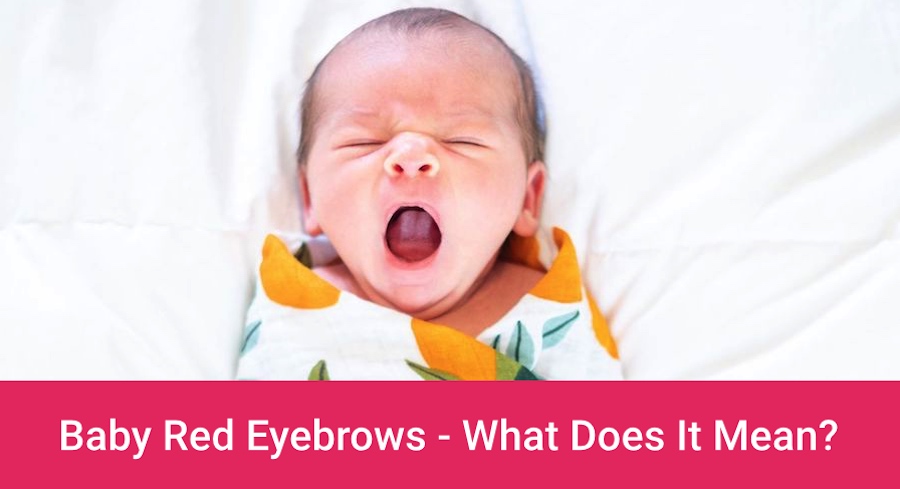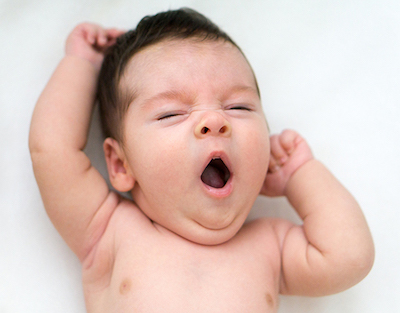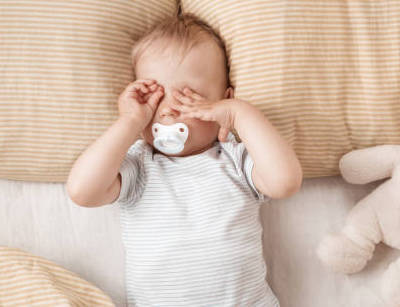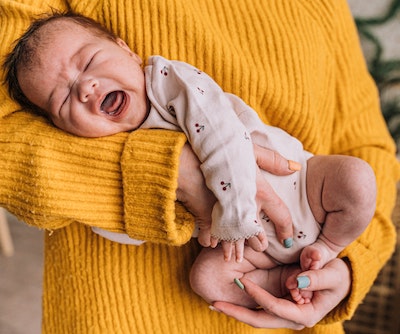
Article by Jessica Pierce – Registered Nurse & Nationally Registered Paramedic
It can be stressful and concerning for you as a parent when you see your baby’s eyebrows turn red. Is it normal? Is it a sign of a medical condition? Does it always mean that your baby is tired and ready for sleep – or could it mean something else?
This interesting cue from your baby is actually really common and usually not a reason to be worried, but it’s important to look out for other signs to be sure about whether baby’s eyebrows are cueing you in to hunger, tiredness, allergies, or something else.
Parents, if you have seen baby’s red eyebrows and are worried about them, keep reading for a complete breakdown of this strange phenomenon as well as some great tips on what you should do about it!
This article is not a substitute for medical advice or consultation.
Why Are My Baby’s Eyebrows Red?
There are many reasons why your baby’s eyebrows or even their whole eye area are red – and fortunately, most of them aren’t a major cause for worry or stress.
The most common causes for eyebrow redness in infants range from hunger to tiredness, to an allergic reaction, or in the worst case scenario, a potential eye infection1. Keep reading for a list of the most common causes, as well as what to do about them!

1. Baby Eyebrows Turn Red When Tired
Believe it or not, red eyebrows are actually one of baby’s many sleep cues. One way to tell if this could be the reason why your baby’s brows are red is to assess for the presence of additional sleep cues to confirm that the eyebrow redness is from being tired or overtired.
Additional common sleep cues include2, but are not limited to:
- Lethargy or decreased interest in play or social interacting
- Decrease in eye contact
- Decreased physical activity
- Baby is quieter or less vocal than usual
- Has brief periods where they appear to be ‘zoning out’ or drifting off to sleep
- Yawning, rubbing their eyes, or increased irritability
Just remember, each baby is going to have different sleepy cues because, well, each baby is different! Pay attention to what’s normal for your little one, and when you see multiple things from this list happening at once, it may be time for bedtime or nap time.

And here are some tips to prevent your baby from becoming overtired in the first place:
- Keep a consistent bedtime
Babies become tired quickly, and once they are overtired, putting them down to sleep or starting a nap becomes much more difficult.
- Set a regular nap schedule as soon as you can
Babies, especially newborns, need frequent naps in order to get the amount of sleep their growing bodies need. Nap length and frequency will be different for different babies, as well as change with time as they get older and need less sleep.
- Learn your baby’s unique sleep cues
Babies are certainly not all the same when they are tired or ready to sleep, so figuring out the specific things to look for when your little one gets tired is key.
2. Baby Eyebrows Go Red When Crying
Parents often notice that their infants get red eyebrows when they cry. Why is this?
The skin on baby’s face is very sensitive and also packed with blood vessels. When an infant cries, they release a hormone called cortisol, which causes the blood vessels around baby’s eyes to dilate – which leads to skin redness.
This fascinating phenomenon is not something to become extremely worried about, fortunately. It is just a normal physiological phenomenon.

3. Baby Gets Red Eyebrows When Upset
Another reason that you may see redness around baby’s eye is from rubbing. Babies are prone to rubbing their eyes when they are crying, which also causes irritation and redness to baby’s eyes.
Encourage a regular, consistent nap schedule to prevent your little one from becoming overtired and minimize the desire to rub their eyes.
4. Do Red Eyebrows Mean Baby Is Hungry?
Could babies eyebrows indicate when it is time for a feeding?
The short answer is, not usually. If your baby’s eyebrows become red before a feeding, it is more likely that the redness is caused by crying or frustration caused by their hunger.
It can be easy to confuse hunger and sleep cues, especially if baby is tired and hungry at the same time, so don’t feel bad if you aren’t sure which of these things (or both!) is going on.

5. Baby Has Red Eyebrows When Feeding
Okay, but what if your baby’s eyebrows continue to get red even while they’re feeding?
Chances are, they are probably also tired. Feeding can take a good amount of effort for little babies, so trying to eat while fighting off sleep can be quite the exhausting pursuit!
Try to feed your little one before they become tired, so hunger does not interfere with their sleep schedule.
6. Can Cradle Cap Affect Eyebrows?
Seborrheic dermatitis, more commonly known as cradle cap, is a skin condition characterized by patches of an itchy, scaly rash. Especially for babies, it is particularly common on areas of the skin that are prone to oiliness, such as the scalp, baby’s face, the upper chest area, and the back.
As a type of eczema, cradle cap can also be a cause of stubborn dandruff or flaky skin in areas that are covered by hair – including babies eyebrows!
-
How Do You Treat Cradle Cap On Eyebrows?
Although cradle cap on babies eyebrows does not necessarily need to be treated, you can help moisturize the skin of the eyebrows by gently massaging some baby oil or petrolatum jelly into the eyebrows about fifteen minutes before you bathe them. This can help to soothe irritated skin.
7. Baby Could Be Too Hot
Overall redness of baby’s skin combined with a hot temperature could indicate that your baby is too hot or in danger of over heating.
It’s important to dress your baby appropriately for sleep to prevent overheating, as babies have more difficulty regulating their internal temperature than adults. In general, baby experts typically recommend dressing babies in one more layer than you would wear to sleep comfortably at night.

8. Baby Might Have A Skin Condition
If baby’s eyebrows are red for days at a time, or accompanied by flaking, itching, a rash, or pimples, the red eyebrows could be related to a skin condition.
There are several conditions that could make your baby’s eyebrows red. Here is a short list of some of them:
- Eczema
Eczema is a common skin condition, especially in newborns. It’s characterized by patches of redness and skin irritation. Generally, infant eczema will go away on its own over time.
- Blocked tear duct
While easily treatable, a blocked tear duct can cause discomfort to the sensitive eyes of an infant. Fortunately, this is a common enough issue for babies and is not typically a cause for major concern.
- Eye infection
If baby’s skin is red and accompanied by swelling, light sensitivity, severe eye pain, or eye drainage, it may be time to call your pediatrician as these symptoms are signs of a possible eye infection. Treatment is typically given in the form of antibiotics, usually via eye drops.
What to do if baby has an eye infection?
If you notice your little one is showing signs of a potential eye infection, take them to see their doctor as soon as you can. It is very easy and usually quite simple to treat an eye infection, but if one is left untreated, there could be serious consequences for your baby.
Untreated eye infections, especially bacterial eye infections, can lead to vision loss or permanent eye damage over time. That is why it’s so important to get your baby’s peepers checked if you notice lots of eye goop or drainage, excessive tears or rubbing of the eye area, or major swelling and eye irritation.
Fortunately, quick treatment means your baby has minimal risk for eye damage!
What Do Red Eyebrows Mean On A Baby?
To sum it all up, there are many many reasons that babies eyebrows might turn red. But rest assured, parents – you’re doing just what you need to do to keep your baby safe.
The main things that red baby eyebrows could possibly mean include sleepiness, frustration, crying, being hot, or a skin or eye condition (again, less likely, but it’s good to know what to look out for!)

Do Red Eyebrows On Baby Always Mean The Baby Is Tired?
Red eyebrows don’t necessarily always mean that your baby is sleepy or exhausted. There are many potential causes, and it’s important to get more information by assessing your infant’s sleepy cues and other symptoms before deciding what to do.
Isn’t it amazing how babies eyebrows can tell us so much? They can show that it is time to sleep, time to eat, or simply indicate that your little one needs some comfort. Babies are truly amazing!
Baby Has Red Eyebrows – What To Do
Here’s a quick overview of steps you can take when you notice your baby’s eyebrows turn red:
- Take inventory of the signs your infant is presenting. Babies, and babies eyebrows, are all different. What cues are unique to yours? Are the signs they are showing you consistent with hunger or tiredness?
- If you notice two or more of your baby’s sleep cues, such as yawning or other signs that they may be overtired, consider starting bedtime a bit early or putting them down for a nap.
- Consider feeding your baby if you notice hunger cues or they have not eaten recently.
- If you notice additional bothersome symptoms, consult with your doctor to rule out any kind of infection or skin condition.
Putting It All Together
Congratulations, parents – you now have all the knowledge and information you need to decipher the many things your baby’s eyebrows could be telling you! It’s a complicated subject, but by making it to the end of this article you’re basically a baby eyebrow expert.
Bookmark this article if your baby frequently presents with red eyebrows, so you have a quick reference guide to determining what’s going on the next time it happens!
Article By Jessica Pierce, RN
Jessica Pierce is Registered Nurse, Nationally Registered Paramedic, writer, and contemporary dance artist based in Tulsa, Oklahoma. She holds two undergraduate degrees from Oral Roberts University – a Bachelor’s of Science in Nursing (2018) and a Bachelor’s of Art in Dance Performance (2019).
The purpose of this article is informative. It’s not a substitute for professional medical advice or medical care. Remember: safety first! Consult your doctor/pediatrician in case of any doubts. The author of this article does not accept any responsibility for any liability, loss or risk, personal or otherwise, incurred as a consequence, directly or indirectly, from any information or advice contained here.
Resources:
https://www.parents.com
https://keababies.com/

